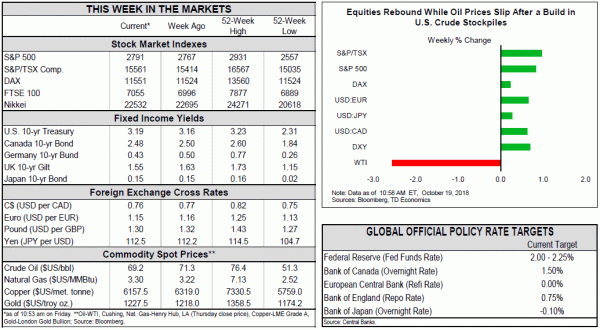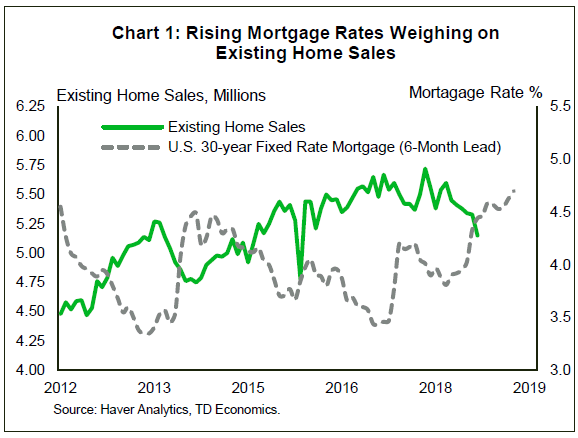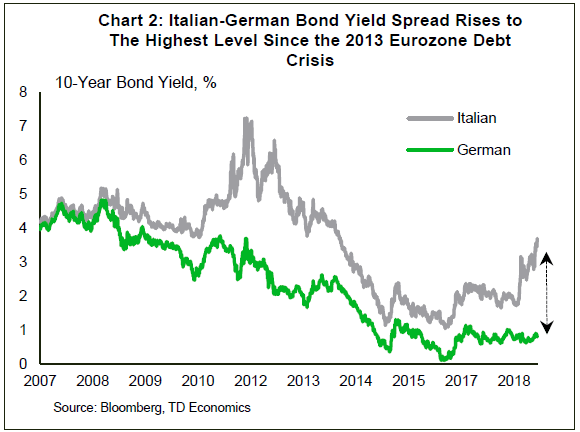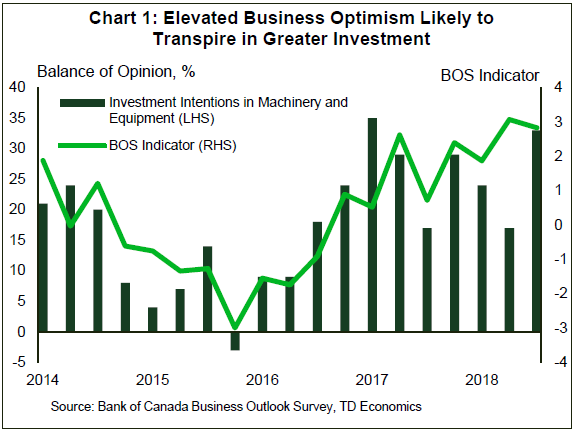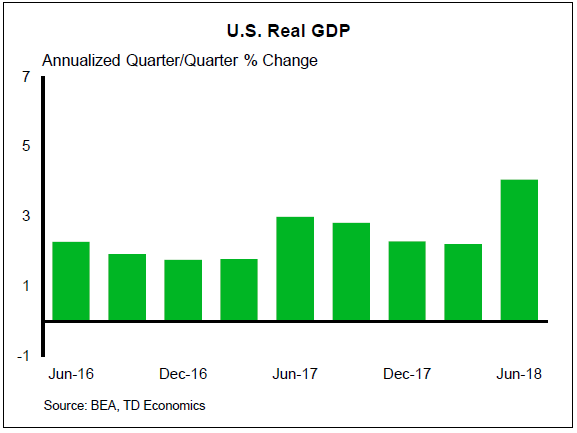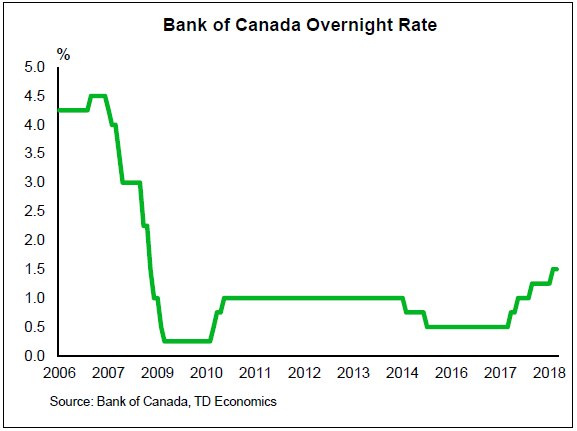U.S. Highlights
- Equity markets stopped hemorrhaging and partially recovered from last week’s downturn. Domestic data was predominantly underwhelming, but did little to change the status quo of a solidly-growing U.S. economy.
- Retail sales, existing home sales and housing starts all fell in September, with figures likely swayed by Hurricane Florence. Core retail sales however, rose by 0.5%, which suggests that consumption grew at a healthy 3% (ann.) in Q3.
- The FOMC minutes reinforced the view for continued interest rates hikes. Still, downside risks are percolating (mostly external) and the path ahead will require careful navigation.
Canadian Highlights
- Indicator data released this week, while mixed, remained consistent on balance with our view that the Canadian economy likely expanded at an above-trend pace in the third quarter.
- Elevated business optimism is likely to transform into action, as a strong sales outlook motivates firms to invest in order to expand capacity.
- With another interest rate hike a done deal next week, evidence may be materializing that higher interest are starting to have an impact on household spending.
U.S. – Plenty of Potholes Will Require Careful Navigation Ahead
Equity markets stopped the hemorrhaging and partially recovered from last week’s downturn. A cocktail of information, which included FOMC minutes, domestic data and thorny international developments, resulted in bouts of volatility. Domestic data was predominantly underwhelming, but did little to change the status quo of a solidly-growing U.S. economy. Retail sales edged up by only 0.1% (m/m) in September – well below market expectations. While disappointing, the report did not raise any red flags. The headline print was likely swayed by Hurricane Florence, given a steep drop in spending at bars and restaurants. More importantly, core sales still rose at a healthy pace of 0.5%, pointing to continued robust momentum in consumption. With September retail sales in the bag, consumer spending in the third quarter likely rose at solid pace of around 3% annualized.
Despite a strong consumer backdrop, the housing market continues to struggle. Existing home sales fell 3.4% in September, marking the sixth straight monthly decline. Housing starts didn’t do any better, falling 5.3% to 1.20 million. Again, part of the weakness can be chalked up to weather-related disruptions, with both existing home sales and starts in the South recording the sharpest drops since late 2015. Going forward, tight inventories of homes for sale should help support moderate gains in new homebuilding. Still, limited supply will keep upward pressure on prices and weigh on demand, especially in the near-term. Rising interest rates, which appear to be behind some of the recent malaise, will be an added headwind (Chart 1).
The FOMC minutes released this week reinforced the view of higher interest rates ahead. The key message here is that as long as the economy continues to expand at a solid pace and inflation remains close to target, the Fed will continue to hike rates, likely by 25 basis points a quarter. In addition, a number of participants believe that it will be necessary to raise rates above neutral temporarily, in order to avoid overshooting inflation or contributing to financial imbalances. For a deeper dive on how high rates can go, see here.
While the data remain supportive of ongoing rate hikes, there is no shortage of potholes in the path ahead, particularly on the international front. Across the pond, Brexit remains a source of uncertainty, while recent developments in Italy have also become a major cause of concern. The EU Commission has determined that Italy’s draft budget is in serious breach of EU budget rules, and may reject it. The Rome-Brussels rift, which has sent Italian bond yields skyward (Chart 2), will bear close watching next week with Italy expected to reply to the commission by Monday. Chinese economic growth is slowing and policymakers there have a tough balancing act between deleveraging and maintaining adequate growth. A sour exchange between trade representatives of the EU and U.S. this week also reminds us that the Trans-Atlantic trade truce rests on feeble foundations. All told, plenty of risks remain and it won’t be an easy path to navigate.
Canada – Higher Interest Rates May be Starting to Bite
This week’s news flow was dominated by the legalization of cannabis nationwide. The economic data was less ebullient, but remained consistent with our view that the Canadian economy expanded at an above trend-pace in the third quarter.
Retail sales in August declined unexpectedly on both a nominal (-0.1% m/m) and volumes basis (-0.3% m/m). The decline in nominal spending appears to have been limited to Saskatchewan, Quebec, Alberta and British Columbia, however seven of eleven retail industries recorded lower sales. This soft print puts some downside risk on our forecast for consumer spending to advance at a 1.8% annualized pace in the third quarter.
The recovery in Canadian existing homes sales also hit a hiccup in September, as national sales slipped 0.4%, marking the first monthly decline since April. Sales slipped in a little over half of all markets. When combined with an uptick in new listings, the supply-demand dynamic remained balanced in most regions, with Quebec remaining as the sole sellers’ market. As a result, growth in the national average existing home price remained subdued, although there were pockets of strength in Ontario and Quebec. Going forward, we anticipate housing activity to inch up gradually, but remain below the peak observed last year as rising borrowing costs and stretched affordability act to keep a lid on demand.
Rounding out the trio of soft data, headline inflation decelerated sharply in September, with CPI up 2.2% y/y versus market expectations for a firmer 2.7% advance. A correction in airfares and travel services were largely responsible for the slowdown. Meanwhile, the Bank of Canada’s trio of core measures each drifted 0.1 percentage points lower to an average of 2.0% in the month.
On a positive note, the Bank of Canada’s Business Outlook Survey for the third quarter revealed that business optimism is likely to transform into action. A solid sales outlook is leading firms to report an increased likelihood to invest not only to meet rising demand, but to also improve productive efficiency (Chart 1). In addition, labour shortages may signal budding wage pressures, adding to the basket of inflationary pressures down the road.
Altogether, this week’s potpourri of data support our view that the Canadian economy continues to expand at a pace strong enough to tolerate higher interest rates. Next week’s Bank of Canada rate hike is a done deal, and another rate hike is likely in the first quarter of 2019, so long as underlying inflation remains near target and real activity transpires as expected. But, as we’ve been cautioning, higher interest rates could reveal the fragility of household spending. As mentioned in our Dollars and Sense publication, if yields rise as projected, Canadian homeowners may see their debt service costs rise to roughly 15% of disposable income. This calls for a more cautious rather than aggressive move up in short term interest rates in the year ahead (Chart 2).
U.S.: Upcoming Key Economic Releases
U.S. Real GDP – Q3 2018
- Release Date: October 25, 2018
- Previous: 4.2%
- TD Forecast: 3.5%
- Consensus: 3.4%
We expect a 3.5% advance in Q3 GDP, reflecting solid consumer spending (3.0%) and an outsized boost from inventories. Business investment is expected to see more modest growth of 2.6%, which we expect is a temporary breather after growing at double digits in the first half of the year. Trade is also expected to be a significant drag in Q3, more than reversing the lift in Q2. Also in the release is core PCE, which we expect to rise 1.5% q/q (annualized), implying a 1.9% y/y print for September.
Canada: Upcoming Key Economic Releases
Bank of Canada Rate Decision
- Release Date: October 24, 2018
- Previous: 1.50%
- TD Forecast: 1.75%
- Consensus: 1.75%
We expect the Bank of Canada to hike rates by 25 bps next week, in line with consensus. Recent economic activity has surprised to the upside relative to the BoC’s last forecast in July and downside risks related to US trade action have diminished with the USMCA deal, so the communique should sound reasonably upbeat. Crucially though, forward looking language should be similar to July, emphasizing a gradual and data dependent tightening path. We expect the Bank to revise their forecast for 2018 growth higher by 0.2 p.p., but we do not expect material changes to forecasts for 2019 and 2020 as tighter financial conditions should roughly offset the boost from greater certainty on trade with the US. Still, with the economy tilting a bit further into excess demand, we now look for three BoC hikes in 2019.




